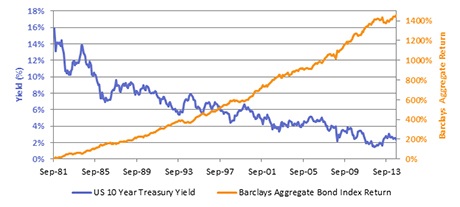Hedge Funds as Fixed Income Replacements?
U.S. 10-Year Treasury yields have steadily declined over the past thirty years. Rates continued to drop in 2014, and in early August dipped to their lowest point since June 2013.[i] Within this context, market participants have long been foretelling interest rates’ inevitable rise, which could spell trouble for DB plan sponsors invested in fixed income (particularly those who increased bond allocations after 2008, given the inverse relationship between bond returns and the direction of interest rates (as shown in Exhibit 1)).[ii]
Exhibit 1: Declining Interest Rates and Bond Returns (Sep-81 to Aug-14)1

With the threat of rising rates, plan sponsors are justifiably concerned that their fixed income returns are not secure and are looking to minimize interest rate risk.
Many investment managers, consultants, and plan sponsors have begun to advocate for hedge funds as fixed income replacements. The argument is compelling:
- Hedge funds2 have been lauded for their bond-like abilities to provide stable returns, help preserve capital, and offer diversification from equity market movements.
- Over full market cycles, compared with bonds, hedge funds have produced similar returns with a fraction of the downside volatility associated with equities.
- Hedge funds’ equity market beta, though higher than that of bonds, is a beneficial diversifier during bear bond market environments.
- Hedge funds often have strong performance during rising rate environments.[iii]
[i] Sommer, J. (August 8, 2014). “Yields on 10-Year Treasuries Fall, Confounding the Experts.” Retrieved from <http://dealbook.nytimes.com/2014/08/08/yields-on-10-year-treasuries-fall-confounding-the-experts/>
[ii] Dorsey, A., J. Amato, B. Tank, & A. Tutrone (January 14, 2014). Solving for 2014: Threading the Needle on Rates and Growth. Pensions&Investments. Neuberger Berman. Retrieved from <https://event.webcasts.com/starthere.jsp?ei=1027558>.
[iii] Kupperman, D. (July 30, 2013). “As Rates Rise, Hedge Funds Show Appeal.” Retrieved from <https://www.nb.com/investable-thinking/article/kupperman_rates_rise_hedge_ funds.html#.UsG3NPRDvlI>.
An allocation to the right group of hedge funds can benefit a well-diversified portfolio, which many plan sponsors have begun to recognize. That said, when contemplating fixed income substitutions, it is important to remember that the fundamental nature of hedge funds is considerably different than that of fixed income. Outlined below are key considerations plan sponsors should understand and reconcile before embarking upon any fixed income replacement initiative.
1. Broad Investment Mandate. In general, hedge funds have broad investment mandates unconstrained by benchmarks—allowing them to make opportunistic investments across capital markets, regardless of market environment, be it rising rates or declining equity markets. The flexible nature of hedge funds is precisely what makes them attractive investments, particularly during interest rate spikes.
However, broad investment mandates can also make asset allocation decisions difficult for plan sponsors. Hedge funds are not an asset class in and of themselves; they do not necessarily share common, identifiable economic drivers with one another, nor can their returns be generally attributed to one set of economic variables. Plan sponsors must be prepared to consider hedge funds and their integration into portfolios on a dynamic basis, outside of traditional portfolio construction theories.
2. Liquidity and Cash Flow. While replacing fixed income investments with hedge funds may result in superior risk-adjusted returns, plans sponsors should know that access to cash flows will be affected. Plan sponsors will forego both the predictability of coupon payments as well as the deep liquidity of the fixed income market. Liquidity terms for hedge funds are broad, and hedge fund managers impose varying lockup and redemption terms. Accordingly, plan sponsors must determine what level of portfolio liquidity is acceptable and consider the illiquidity premium hedge funds can offer.
3. Risk. While hedge fund portfolios have historically provided stable returns over full market cycles, they may experience periods of pronounced volatility. This volatility has generally been more moderate than that of equities but greater than that of fixed income. Hedge funds are best considered as long-term investments. Plan sponsors should not only understand hedge funds’ more volatile nature—particularly in light of historically low bond volatility—but also be prepared to maximize hedge funds’ utility in the long-term preservation of capital rather than short-term gain.
Hedge funds are a compelling option for plan sponsors looking for alternatives to fixed income—they offer returns with low correlations to interest rates and equity markets, moderate long-term volatility, and diversification. They are, however, complex investments. Before making any asset allocation decisions, plan sponsors must understand the nature of hedge funds and, importantly, consider this nature within the context of their portfolios. Whether hedge funds are appropriate fixed income replacements will depend greatly on plan sponsors’ expectations and portfolio requirements.
Kurt Braitberg, CFA, CAIA, is a managing director at TeamCo Advisers.
NOTE: This feature is to provide general information only, does not constitute legal advice, and cannot be used or substituted for legal or tax advice.
Past performance is not necessarily indicative of future results. Investors should be aware that an investment in hedge funds is speculative and involves a high degree of risk. Performance can be volatile and an investor could lose all or a substantial amount of its capital. This analysis and review are being provided for informational purposes only and should not be considered either an offer of or a solicitation to purchase or participate in any of the particular services or securities referred to herein. No representation is made that any investor could have constructed a portfolio that would have replicated this performance.
This material contains the current opinions of professionals associated with TeamCo, and such opinions are subject to change without notice. This material is distributed for informational purposes only and should not be considered as investment advice or a recommendation of any particular security, fund, strategy, or investment product. Information contained herein has been obtained from sources believed to be reliable, but is not guaranteed by TeamCo. This material is not an offer to sell or a solicitation of an offer to buy any security or investment. This material does not contain the information that an investor should consider or evaluate in making a potential investment. Offering materials relating to investments in any entity that may be managed or advised by TeamCo are not available to the general public. Investors should consult with their professional advisers prior to making any investment decision. No part of this material may be reproduced in any form, or referred to in any other publication, without the express written permission of TeamCo.
Any opinions of the author(s) do not necessarily reflect the stance of Asset International or its affiliates.
1 Referenced time period is Sep-81 to Aug-14 for the Barclays Aggregate Bond Index. Data source: PerTrac.
2 HFRI Fund of Funds Composite Index is used as a proxy for hedge fund returns throughout this material. While all hedge fund indices suffer some biases, TeamCo believes the HFRI Fund of Funds Composite Index suffers the least as it eliminates hedge fund survivorship bias.


